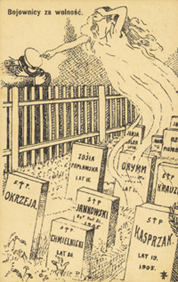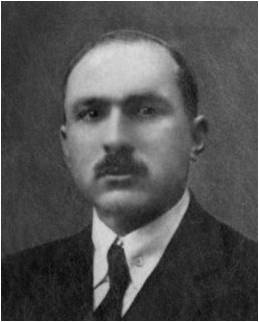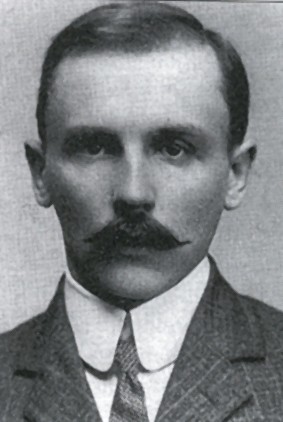The interwar Communist Party of Poland was a communist party active in Poland during the Second Polish Republic. It resulted from a December 1918 merger of the Social Democracy of the Kingdom of Poland and Lithuania (SDKPiL) and the Polish Socialist Party – Left into the Communist Workers' Party of Poland. The communists were a small force in Polish politics.

The Polish Workers' Party was a communist party in Poland from 1942 to 1948. It was founded as a reconstitution of the Communist Party of Poland (KPP) and merged with the Polish Socialist Party (PPS) in 1948 to form the Polish United Workers' Party (PZPR). From the end of World War II the PPR led Poland, with the Soviet Union exercising moderate influence. During the PPR years, the centers of opposition activity were largely diminished, and a socialist system was established in the country.

Józef Adam Zygmunt Cyrankiewicz was a Polish Socialist (PPS) and after 1948 Communist politician. He served as premier of the Polish People's Republic between 1947 and 1952, and again for 16 years between 1954 and 1970. He also served as Chairman of the Polish Council of State from 1970 to 1972.

Edward Bolesław Osóbka-Morawski was a Polish activist and politician in the Polish Socialist Party (PPS) before World War II, and after the Soviet takeover of Poland, Chairman of the Communist-dominated interim government, the Polish Committee of National Liberation formed in Lublin with Stalin's approval.

The Provisional Government of National Unity was a puppet government formed by the decree of the State National Council on 28 June 1945 as a result of reshuffling the Soviet-backed Provisional Government of the Republic of Poland established by the Polish Workers' Party through inclusion of politicians from the close political sphere of Stanisław Mikołajczyk, the former prime minister of the Polish government-in-exile based in London. Inclusion of the latter group provided an excuse for the Western allies to approve tacitly the fait accompli of Poland becoming part of the Soviet sphere of influence, and to legitimise the Warsaw government while withdrawing their recognition of the Polish government-in-exile.

The Social Democracy of the Kingdom of Poland and Lithuania, originally the Social Democracy of the Kingdom of Poland (SDKP), was a Marxist political party founded in 1893 and later served as an autonomous section of the Russian Social Democratic Labour Party. It later merged into the Communist Workers Party of Poland. Its most famous member was Rosa Luxemburg.

The Combat Organization of the Polish Socialist Party was an illegal Polish guerrilla organization founded in 1904 by Józef Piłsudski.

Związek Ludowo-Narodowy was a Polish political party aligned with the National Democracy political movement during the Second Polish Republic, gathering together right-wing politicians with conservative and nationalist opinions.

The Łódź insurrection, also known as the June Days, was an uprising by Polish workers in Łódź against the Russian Empire between 21 and 25 June 1905. This event was one of the largest disturbances in the Russian-controlled Congress Poland during the Russian Revolution of 1905. Poland was a major center of revolutionary fighting in the Russian Empire in 1905–1907, and the Łódź insurrection was a key incident in those events.

The Polish Socialist Party – Revolutionary Faction also known as the Old Faction was one of two factions into which the Polish Socialist Party split in 1906. The Revolutionary Faction's primary goal was to restore an independent Poland, which was envisioned as a representative democracy. It saw itself as a spiritual successor to the Red Faction of the 1863 January Uprising, which had the goal of creating an independent Polish-Lithuanian-Ruthenian Commonwealth.

Polish Socialist Party – Left, also known as the Young Faction, was one of two factions into which Polish Socialist Party divided itself in 1906 at its ninth congress. Its primary goal was transform Poland into a socialist country, established through proletarian revolution, and likely a member of some international communist country.

Kazimierz Pużak (1883–1950) was a Polish socialist politician of the interwar period. Active in the Polish Socialist Party, he was one of the leaders of the Polish Secret State and Polish resistance, sentenced by the Soviets in the infamous Trial of the Sixteen in 1945.

A major part of the Russian Revolution of 1905 took place in the Russian Partition of Poland and lasted until 1907. It was the largest wave of strikes and widest emancipatory movement that Poland had ever seen until the 1970s and the 1980s. One of the major events of that period was the insurrection in Łódź in June 1905. Throughout that period, many smaller demonstrations and armed struggles between the peasants and workers on one side and the government on the other took place. The demands of the demonstrators included the improvement of the workers' living conditions, as well as political freedoms, particularly related to increased autonomy for Poland. Particularly in 1905, Poland was at the verge of a new uprising, revolution or civil war. Some Polish historians even consider the events of that period a fourth Polish uprising against the Russian Empire.

Tytus Filipowicz (1873–1953) was a Polish politician and diplomat.

The Movement of the Urban and Rural Working Masses – Freedom, Equality, Independence, commonly known as Polish Socialist Party – Freedom, Equality, Independence and abbreviated as PPS-WRN or just WRN, was an underground organisation in occupied Poland during World War II set up by the activists of the Polish Socialist Party (PPS) and continuing its traditions. The party leadership used the name Central Leadership of the Movement. Within the Political Consultative Committee, the organization used the code name "Koło".

Polish Socialist Party – Freedom, Equality, Independence often referred to simply as Militia PPS-WRN, was a Polish underground paramilitary formation of the Polish Socialist Party – Freedom, Equality, Independence active during the occupation of Poland by Nazi Germany and the Soviet Union in World War II between 1939 and 1945. The total number of clandestine members of MR PPS-WRN reached 30,000 at the time of the Soviet counter-offensive of 1944. They participated in both Operation Tempest against the Nazis and in the Warsaw Uprising of 1944. MR PPS-WRN was created in November 1939 amongst the prewar labour circles in Warsaw, Radom, Kraków, in Upper Silesia (Śląsk) and in the Dąbrowa Basin (Zagłębie) mainly for self-protection. It was supposed to help recreate the Polish prewar police and counter—intelligence services.

Andrzej Strug, real name TadeuszGałecki was a Polish socialist politician, publicist and activist for Poland's independence. He was also a freemason and declined the offer to join the prestigious Polish Academy of Literature, upset by official criticism of the movement.
The Polish Communist Party, or the Communist Party of Poland, is an anti-revisionist Marxist–Leninist communist party in Poland founded in 2002 claiming to be the historical and ideological heir of the Communist Party of Poland, Polish Workers' Party and the Polish United Workers' Party.
















